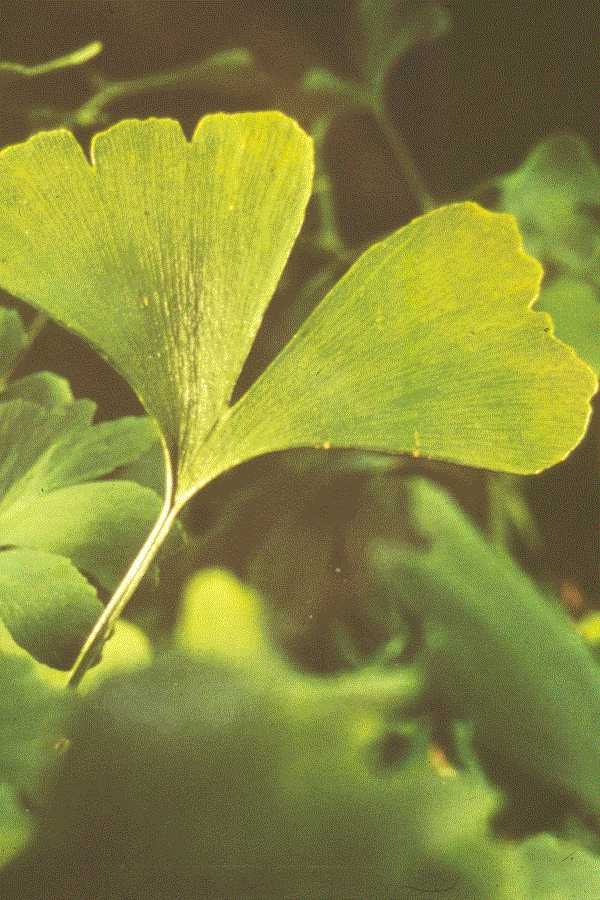The word Ginkgo comes from a misspelling of the Japanese word "ginkyo" or "silver apricot." Other people attribute the word to the older Chinese word meaning "silver fruit."
Not that you'd want to hang around the fruit of the female ginkgo tree. While most plants are hermaphrodites, ginkgos have separate male and female trees. The female trees produce fruit that become a mushy, foul-smelling mess on city sidewalks in the fall. The fruit contains butanoic acid, which makes it smell like rancid butter. For this reason, landscape suppliers will only sell male cultivars, or trees that are male clones of existing trees, to ensure maleness. Don't know if your Ginkgo is male or female? Don't let a few years of non-smelliness convince you - female trees will not fruit for 20 years more. (Ours is a male cultivar.)
Ginkgos are deciduous dioecious gymnosperms (deciduous = they lose leaves yearly, dioecious = male and female are separate, gymnosperm = "naked seed," meaning their seeds are not encased in ripened fruit, although the females do not produce actual cones.)
Kingdom Plantae -- Plants
Subkingdom Tracheobionta -- Vascular plants
Superdivision Spermatophyta -- Seed plants
Division/phylum Ginkgophyta -- Ginkgo
Class Ginkgoopsida
Order Ginkgoales
Family Ginkgoaceae -- Ginkgo family
Genus Ginkgo L.

The only living member of the Order Ginkgoales is the Ginkgo biloba! The word biloba means "two-lobed" and refers to its distinctive leaf shape.
Many people take Ginkgo biloba extracts (widely available at drugstores) for a variety of health issues, however, most often as a memory enhancer (to improve memory). "Some smaller studies for memory enhancement have had promising results, but a trial sponsored by the National Institute on Aging of more than 200 healthy adults over age 60 found that ginkgo taken for 6 weeks did not improve memory," as reported in a 2002 JAMA article.
SOURCES: Ohio State Horticulture Page, National Institute of Heath (NIH) Ginkgo Fact Sheet, The Ginkgo Pages.
2 comments:
Request - Book/project "Nature's miracle - Ginkgo biloba L. 1771 - All about ginkgo (or maidenhair tree)" Vol 1-4, subtitle: Will ginkgo be the saviour of the human kind?
Dear Dr. Christine!
I live in Croatia (Europe) and write a book about ginkgo for print & digital forms. Type of the book is: scientifically-popular.
My question is:
if you allow me to publish a your photo about planting ginkgo tree?
Photo has been signed (Vol 1, part 4):
"Planting about 15 years old ginkgo tree. Photo by www.mytko.org, USA.
(Source: http://mytko.org/random/ginkgo2.JPG )" - or how you want it?
(+ "Special thanks")
See please “Operating contents” project "Nature's miracle • Ginkgo biloba L. 1771 - All about ginkgo (or maidenhair tree)" (Vol 1-4) here: http://www.ginkgo-project.blogspot.com/
"Nature's miracle
Ginkgo biloba L. 1771 - All about ginkgo (or maidenhair tree) - Vol 1-4 (Will ginkgo be the saviour of the human kind?)"
Vol 1 - Ginkgo in general - Lets get to know ginkgo (270 p. - Completed)
Vol 2 - Cultivars and bonsai forms (158 p. - Completed about 01/06/2011)
Vol 3 - Medicine and food - unrivalled (Will ginkgo be the saviour of the human kind?) (152 p.)
Vol 4 - Ginkgo as inspiration - through out the history and today (154 p.)
Vol 2 (Cultivars and bonsai) will be finalized in May/June 2011. Vol 3 and 4 will be completed by July/August 2011.
Foreword (Introduction) by:
• Prof. Sir Peter Crane, Dr.Sc. (Director of the Royal Botanic Gardens in Kew, London, UK, etc. and today - Yale School of Forestry and Environmental Studies at Yale University in New Haven, Connecticut, USA)
• Prof. Peter Del Tredici, Dr.Sc. (Senior Research Scientist Arnold Arboretum of Harvard University, Boston - Lecturer, Harvard Graduate School of Design, Cambridge, USA)
• Prof. Ing. Pavel Hrubík, Dr.Sc. (Slovak Agricultural University in Nitra, Slovakia)
• Elvira Koić, Mr.Sc. (General Hospital Virovitica, Head of psychiatry, Virovitica, etc., Croatia)
• Prof. László Orlóci, Dr.Sc. (ELTE Botanical Garden, Budapest, Hungary)
• Rade Rakić, M.S. (Croatian Forests of Croatia, Head of botanical nursery, Krizevci, Croatia)
• Assoc. Prof. Ing. Katarína Ražná, Dr.Sc. (Department of genetics and plant breeding, Faculty of agriculture and food resources, Slovak Agricultural University in Nitra, Slovakia)
• Dirk and Cor van Gelderen (PlantenTuin Esveld, Boskoop, Netherlands)
• Prof. Zhi-Yan Zhou, Member of CAS - Academician (State Key Laboratory of Palaeobiology and Stratigraphy, and Department of Palaeobotany and Palynology, Nanjing Institute of Geology and Palaeontology, Chinese Academy of Sciences, China)
Thank you very much in advance.
Best regards!
Branko M. Begovic Bego
Otrovanec 60
33405 Pitomaca
Croatia
Contact e-mail: ginkgo.begovic@gmail.com
It is good that you have a Ginkgo Tree in your backyard. They take years and years to grow.
Post a Comment